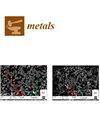Extraction of Cobalt and Manganese from Ferromanganese Crusts Using Industrial Metal Waste through Leaching
IF 2.5
3区 材料科学
Q3 MATERIALS SCIENCE, MULTIDISCIPLINARY
引用次数: 0
Abstract
Ferromanganese crusts are mineral resources distributed in the planet’s oceans. These deep-sea minerals stand out for their abundance and diversity of metals, with Mn and Co being the most abundant elements. These minerals are a good alternative to diversify the extraction of elements, which today are found at low grades on the Earth’s surface. For the co-processing of ferromanganese crusts to recover Co and Mn, there are few studies. These generally worked with the use of a reducing agent, and in many cases previous roasting processes. In the present investigation, two ferromanganese crusts that were collected from two seamounts in the central eastern Atlantic Ocean were characterized. Subsequently, these crusts were leached in an acid-reducing medium, adding steel waste (slag) with 99.73% Fe3O4 and 0.27% metallic iron from the steel industry as a reducing agent. Acid-reducing processes have previously been shown to yield high and rapid recoveries of Co and Mn from seabed minerals. However, there is no previous study using smelting slag as a reducing agent for the treatment of ferromanganese crusts. The best results of this research were obtained when working at 60 C, achieving joint extractions of Co and Mn of ~80% and ~40%, respectively, in 10 min. In addition, the process residues were analyzed, and the formation of contaminating elements or the precipitation of Co and Mn species was not observed.利用工业金属废料通过浸出法从锰铁结壳中提取钴和锰
铁锰结壳是分布在地球海洋中的矿物资源。这些深海矿物的突出特点是金属含量丰富且种类繁多,其中锰和钴是含量最高的元素。这些矿物是实现元素提取多样化的良好选择,目前在地球表面发现的元素品位较低。关于对锰铁结壳进行共处理以回收钴和锰的研究很少。这些研究通常使用还原剂,在许多情况下使用以前的焙烧工艺。在本次调查中,对从大西洋中东部两座海山采集的两块铁锰结壳进行了特征描述。随后,在酸还原介质中对这些结壳进行了沥滤,并添加了钢铁工业中含有 99.73% Fe3O4 和 0.27% 金属铁的钢铁废料(炉渣)作为还原剂。以前的研究表明,酸还原过程可以从海底矿物中快速回收大量的钴和锰。然而,之前还没有使用冶炼渣作为还原剂处理锰铁结壳的研究。这项研究的最佳结果是在 60 C 温度下工作,10 分钟内钴和锰的联合萃取率分别达到 ~80% 和 ~40%。此外,还对工艺残留物进行了分析,未观察到污染元素的形成或 Co 和 Mn 物种的沉淀。
本文章由计算机程序翻译,如有差异,请以英文原文为准。
求助全文
约1分钟内获得全文
求助全文
来源期刊

Metals
MATERIALS SCIENCE, MULTIDISCIPLINARY-METALLURGY & METALLURGICAL ENGINEERING
CiteScore
4.90
自引率
13.80%
发文量
1832
审稿时长
1.5 months
期刊介绍:
Metals (ISSN 2075-4701) is an open access journal of related scientific research and technology development. It publishes reviews, regular research papers (articles) and short communications. Our aim is to encourage scientists to publish their experimental and theoretical results in as much detail as possible. Therefore, there is no restriction on the length of the papers. The full experimental details must be provided so that the results can be reproduced. Metals provides a forum for publishing papers which advance the in-depth understanding of the relationship between the structure, the properties or the functions of all kinds of metals.
 求助内容:
求助内容: 应助结果提醒方式:
应助结果提醒方式:


